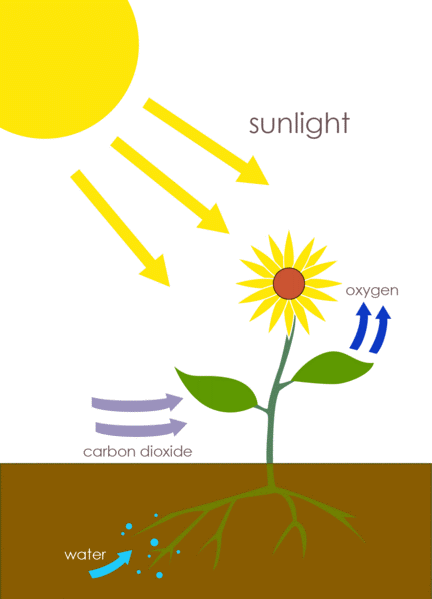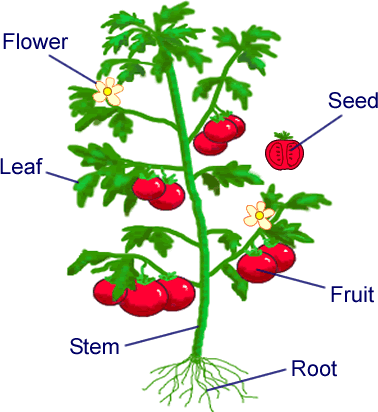Photosynthesis, Nutrients, Soil & Basic Plant Information

Photosynthesis is a chemical process! Processes have an order or instructions that need to be followed just like a recipe needs to be followed in order to make food.
All chemical processes have equations and the one for photosynthesis looks like:
carbon dioxide + water + light → sugar + oxygen
Carbon dioxide, water, and light are the ingredients plants need in order to make their food to grow.
Carbon dioxide is a gas that we humans breathe out. Plants need to take in carbon dioxide as part of their nourishment. Plants need to drink water! They too must stay hydrated. They drink through their roots, which are found under the soil. Plants need the sun’s light to grow. The sun’s rays help the plant process the carbon dioxide and water to turn it into food!
As a result, plants create sugar and oxygen. The sugar is their food and oxygen helps us and most all living organisms survive!

Nutrients
There are 16 chemical elements that are known to be important to plant growth and survival. They are broken up into non-mineral nutrients and mineral nutrients. Non-mineral nutrients are found in the air and water. They are hydrogen (H), oxygen (O), and carbon (C). Mineral nutrients come from the soil. These nutrients are absorbed by the plants roots when uptaking water.
Mineral nutrients are broken up into macronutrients and micronutrients.
- The most important primary macronutrients for plants are nitrogen (N), phosphorus (P), and potassium (K). However, these elements are usually lacking from the soil because plants use large quantities of each for their growth. This is why farmers and gardeners use fertilizers to add these macronutrients to the soil. The secondary macronutrients are calcium (Ca), manganese (Mg), and sulfur (S). Fertilizer is not always needed because there is usually enough of these elements in the ground for plants to absorb.
- Micronutrients are elements that plants use small or micro quantities. These nutrients are boron (B), copper (Cu), iron (Fe), chloride (Cl), manganese (Mn), molybdenum (Mo), zinc (Zn).
Learn more about plant nutrients and why they are important to plant growth here!
Soil
Soil is made up of living and non living material. Four components of soil are:
- 45% rock particles
- 25% water
- 25% air
- 5% leaves or organic matter (decaying animal and plant matter)
Soil Types
- Soil types are determined by how much sand, silt, and clay there is in the soil.
- Sand- it is the largest particle in the soil. Sand feels rough because of the sharp edges. These particles do not hold much nutrients.
- Silt- its size is in between sand and silt. Silt feels smooth and powdery when dry and feels smooth when wet.
- Clay- is the smallest of the three particles. Clay feels smooth when dry and sticky when wet. Clay holds the most nutrients out of the three but is not very porous. Water and air do not flow through it well.
Soil for Gardening in Containers
- When growing plants in containers it is best to use artificial soils or soilless mixes rather than soil from a garden. Soilless mixes are best because they are clean, lightweight, and provide excellent drainage. However, these artificial mixes do not hold nutrients well so you will have to fertilize your plants regularly to keep them healthy.
- Why not use garden soil? It usually contains weed seeds, disease organisms, and does not drain well. If you want to use garden soil, it is recommended to mix the soil with peat and sand to improve the drainage. The following is a good recipe to make soil for containers using garden soil:
- 1 part soil
- 1 part peat (partially decayed matter)
- 1 part course sand or perlite (hard, rock-like material)
Composting
Want to make your own soil? Try composting!
Composting is a great way to make a nutrient rich mix that can restore depleted soil. Composting can reduce the amount of waste that goes in landfills. 1/3rd of landfill waste is compostable material. It is great for the environment and introduces helpful organisms to the soil. These organisms break down nutrients for the plant and can ward of disease!
The basic ingredients in a compost pile are
- Carbon rich matter (from organic matter like leaves, stems, branches, wood, sawdust, shredded brown paper bags, corn stalks, coffee filters, egg shells, straw , peat, moss, wood ash)
- Nitrogen rich or protein rich matter (manures, food scraps, green lawn clippings, and green leaves)
The key is to have a healthy balance between these two elements. A healthy pile should have more carbon than nitrogen. A good rule of thumb is to have 1/3 nitrogen rich matter and 2/3 carbon rich matter in the pile. Too much nitrogen make a dense and smelly pile, but with a carbon rich pile it often puts out a fresh and wonderful smell!
Click here to learn more about this soil information! Also available in Spanish!

Basic Plant Parts
- Roots- provide support by anchoring plant and absorbing water and nutrients needed for plant growth
- Stems- move water and nutrients that have been absorbed by the roots to the plants leaves. They also provide the plant with support and the ability to stand tall so leaves are able to absorb sunlight to produce food and grow
- Leaves- the leaves are the part of the plant where photosynthesis happens. Leaves catch light and change the carbon dioxide and water into food to grow
- Flowers- are important for reproduction. A flower has male female parts. When the male part is moved to the female part and fertilizes it, the production of seeds and fruit result. This is called pollination. Some plants rely on the wind to move their pollen, and some rely on pollinators, such as bees, butterflies, and bats. Seeds and fruits that are not eaten will grow into a new plant.
- Seeds- embryos of plants that are capable to grow into new plants
Click here to learn more about the basic plant parts! Also available in Spanish!
